 |
 |
Our enthusiastic and extremely knowledgeable perennials team is here to answer your questions and help you choose the best perennials for your situation. There’s always something in bloom for sun, shade, butterflies, birds or deer resistance as well as a variety of bulbs for your space.
Stroll through our time-tested favorites and introduce yourself to the newest varieties. We garden with perennials too; we love them and it shows!
|
29 found, showing page 1 of 2
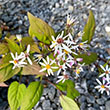
Height: 30 inches
Spread: 30 inches
Sunlight: partial shade full shade
Hardiness Zone: 3a
Other Names: syn. Aster divaricatus, White Star Aster
Description:
A profusion of airy white flowers with gold to red eyes, over a mound of small green leaves; thrives in shade and tolerates dry conditions; water the root zone instead of from the top to reduce fungal disease; water regularly to encourage more blooms
Ornamental Features:
White Wood Aster has masses of beautiful white flat-top daisy flowers with gold eyes at the ends of the stems from mid to late summer, which are most effective when planted in groupings. Its small heart-shaped leaves remain light green in color throughout the season.
Landscape Attributes:
White Wood Aster is an herbaceous perennial with an upright spreading habit of growth. It brings an extremely fine and delicate texture to the garden composition and should be used to full effect.
This is a relatively low maintenance plant, and is best cleaned up in early spring before it resumes active growth for the season. It is a good choice for attracting butterflies to your yard, but is not particularly attractive to deer who tend to leave it alone in favor of tastier treats. Gardeners should be aware of the following characteristic(s) that may warrant special consideration: Disease
White Wood Aster is recommended for the following landscape applications:
- Mass Planting
- Rock/Alpine Gardens
- Border Edging
- General Garden Use
- Groundcover
- Naturalizing And Woodland Gardens
- Container Planting
Planting & Growing:
White Wood Aster will grow to be about 30 inches tall at maturity, with a spread of 30 inches. Its foliage tends to remain dense right to the ground, not requiring facer plants in front. It grows at a medium rate, and under ideal conditions can be expected to live for approximately 4 years. As an herbaceous perennial, this plant will usually die back to the crown each winter, and will regrow from the base each spring. Be careful not to disturb the crown in late winter when it may not be readily seen!
This plant does best in partial shade to shade. It prefers to grow in average to dry locations, and dislikes excessive moisture. It is considered to be drought-tolerant, and thus makes an ideal choice for a low-water garden or xeriscape application. This plant should not require much in the way of fertilizing once established, although it may appreciate a shot of general-purpose fertilizer from time to time early in the growing season. It is not particular as to soil type or pH. It is somewhat tolerant of urban pollution. This species is native to parts of North America. It can be propagated by division.
White Wood Aster is a fine choice for the garden, but it is also a good selection for planting in outdoor pots and containers. With its upright habit of growth, it is best suited for use as a 'thriller' in the 'spiller-thriller-filler' container combination; plant it near the center of the pot, surrounded by smaller plants and those that spill over the edges. It is even sizeable enough that it can be grown alone in a suitable container. Note that when growing plants in outdoor containers and baskets, they may require more frequent waterings than they would in the yard or garden.

Plant Height: 12 inches
Flower Height: 18 inches
Spacing: 18 inches
Sunlight: partial shade full shade
Hardiness Zone: 2b
Other Names: False Spirea
Description:
An upright-mounded, low maintenance and shade loving variety; pure white plumes rise above mounds of ferny foliage; an excellent addition to shaded gardens, borders, containers or moon gardens; low maintenance
Ornamental Features:
Bridal Veil Astilbe has masses of beautiful plumes of white flowers at the ends of the stems from late spring to early summer, which are most effective when planted in groupings. The flowers are excellent for cutting. Its ferny compound leaves remain emerald green in color throughout the season.
Landscape Attributes:
Bridal Veil Astilbe is an herbaceous perennial with an upright spreading habit of growth. Its relatively fine texture sets it apart from other garden plants with less refined foliage.
This is a relatively low maintenance plant, and is best cleaned up in early spring before it resumes active growth for the season. It is a good choice for attracting butterflies to your yard, but is not particularly attractive to deer who tend to leave it alone in favor of tastier treats. It has no significant negative characteristics.
Bridal Veil Astilbe is recommended for the following landscape applications:
- Mass Planting
- Rock/Alpine Gardens
- Border Edging
- General Garden Use
- Container Planting
- Planting & Growing
Bridal Veil Astilbe will grow to be about 12 inches tall at maturity extending to 18 inches tall with the flowers, with a spread of 24 inches. When grown in masses or used as a bedding plant, individual plants should be spaced approximately 18 inches apart. Its foliage tends to remain dense right to the ground, not requiring facer plants in front. It grows at a medium rate, and under ideal conditions can be expected to live for approximately 10 years. As an herbaceous perennial, this plant will usually die back to the crown each winter, and will regrow from the base each spring. Be careful not to disturb the crown in late winter when it may not be readily seen!
This plant does best in partial shade to shade. It requires an evenly moist well-drained soil for optimal growth. It is very fussy about its soil conditions and must have rich, acidic soils to ensure success, and is subject to chlorosis (yellowing) of the foliage in alkaline soils. It is somewhat tolerant of urban pollution, and will benefit from being planted in a relatively sheltered location. Consider applying a thick mulch around the root zone over the growing season to conserve soil moisture. This particular variety is an interspecific hybrid. It can be propagated by division; however, as a cultivated variety, be aware that it may be subject to certain restrictions or prohibitions on propagation.
Bridal Veil Astilbe is a fine choice for the garden, but it is also a good selection for planting in outdoor pots and containers. It is often used as a 'filler' in the 'spiller-thriller-filler' container combination, providing a mass of flowers against which the larger thriller plants stand out. Note that when growing plants in outdoor containers and baskets, they may require more frequent waterings than they would in the yard or garden.
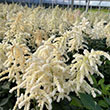
Soft, feathery, white flower heads bloom through the summer. Deer and rabbit resistant. USDA 4-9
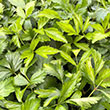
Clean white flowers on wide, feathery plumes. Blooms in early to midsummer. Bright green leaves. USDA 4-9
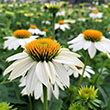
Plant Height: 18 inches
Flower Height: 24 inches
Spread: 18 inches
Sunlight: full sun
Hardiness Zone: 3a
Other Names: Pow Wow White Coneflower
Brand: Proven Winners
Description:
This attractive echinacea produces large pure white flowers with coppery centers; a perfect choice for planting in groups, along border edges, or in containers; great for flower arrangements, attracts pollinators
Ornamental Features:
PowWow White Coneflower has masses of beautiful lightly-scented white daisy flowers with coppery-bronze eyes at the ends of the stems from mid summer to early fall, which are most effective when planted in groupings. The flowers are excellent for cutting. Its pointy leaves remain green in color throughout the season.
Landscape Attributes:
PowWow White Coneflower is an herbaceous perennial with an upright spreading habit of growth. Its medium texture blends into the garden, but can always be balanced by a couple of finer or coarser plants for an effective composition.
This is a relatively low maintenance plant, and is best cleaned up in early spring before it resumes active growth for the season. It is a good choice for attracting birds and butterflies to your yard, but is not particularly attractive to deer who tend to leave it alone in favor of tastier treats. It has no significant negative characteristics.
PowWow White Coneflower is recommended for the following landscape applications:
- Mass Planting
- General Garden Use
- Container Planting
Planting & Growing:
PowWow White Coneflower will grow to be about 18 inches tall at maturity extending to 24 inches tall with the flowers, with a spread of 18 inches. It grows at a medium rate, and under ideal conditions can be expected to live for approximately 10 years. As an herbaceous perennial, this plant will usually die back to the crown each winter, and will regrow from the base each spring. Be careful not to disturb the crown in late winter when it may not be readily seen!
This plant should only be grown in full sunlight. It is very adaptable to both dry and moist locations, and should do just fine under typical garden conditions. It is considered to be drought-tolerant, and thus makes an ideal choice for a low-water garden or xeriscape application. It is not particular as to soil type or pH. It is highly tolerant of urban pollution and will even thrive in inner city environments. This is a selection of a native North American species. It can be propagated by division; however, as a cultivated variety, be aware that it may be subject to certain restrictions or prohibitions on propagation.
PowWow White Coneflower is a fine choice for the garden, but it is also a good selection for planting in outdoor pots and containers. With its upright habit of growth, it is best suited for use as a 'thriller' in the 'spiller-thriller-filler' container combination; plant it near the center of the pot, surrounded by smaller plants and those that spill over the edges. Note that when growing plants in outdoor containers and baskets, they may require more frequent waterings than they would in the yard or garden.
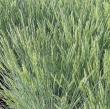
Height: 8 inches
Spread: 12 inches
Sunlight: full sun, partial shade
Hardiness Zone: 2b
Other Names: Festuca ovina var. glauca
Description:
A dwarf ornamental grass featuring bright silver-blue foliage; neat mounds of densely tufted leaves stay blue all season long; tall upright tan plumes sway in the breeze; drought tolerant once established, great for containers, beds and borders
Ornamental Features:
Elijah Blue Fescue is primarily valued in the garden for its interestingly mounded form. Its attractive grassy leaves remain blue in color throughout the year. The tan seed heads are carried on spikes from mid summer to late fall.
Landscape Attributes:
Elijah Blue Fescue is an herbaceous evergreen perennial grass with a mounded form. It brings an extremely fine and delicate texture to the garden composition and should be used to full effect.
This is a relatively low maintenance plant, and is best cleaned up in early spring before it resumes active growth for the season. It has no significant negative characteristics.
Elijah Blue Fescue is recommended for the following landscape applications:
- Rock/Alpine Gardens
- Border Edging
- General Garden Use
- Naturalizing And Woodland Gardens
- Container Planting
Planting & Growing:
Elijah Blue Fescue will grow to be about 8 inches tall at maturity, with a spread of 12 inches. Its foliage tends to remain low and dense right to the ground. It grows at a medium rate, and under ideal conditions can be expected to live for approximately 8 years. As an evegreen perennial, this plant will typically keep its form and foliage year-round.
This plant does best in full sun to partial shade. It prefers to grow in average to dry locations, and dislikes excessive moisture. It is considered to be drought-tolerant, and thus makes an ideal choice for a low-water garden or xeriscape application. It is not particular as to soil type or pH. It is highly tolerant of urban pollution and will even thrive in inner city environments. This is a selected variety of a species not originally from North America. It can be propagated by division; however, as a cultivated variety, be aware that it may be subject to certain restrictions or prohibitions on propagation.
Elijah Blue Fescue is a fine choice for the garden, but it is also a good selection for planting in outdoor pots and containers. It is often used as a 'filler' in the 'spiller-thriller-filler' container combination, providing a canvas of foliage against which the thriller plants stand out. Note that when growing plants in outdoor containers and baskets, they may require more frequent waterings than they would in the yard or garden.
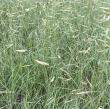
Blue Grama Grass 'Blonde Ambition' | Chartreuse flowers & tan Seed Heads. Naturalizing. USDA 3-10

Height: 5 feet
Spread: 3 feet
Sunlight: full sun partial shade
Hardiness Zone: 2b
Ornamental Features:
Switch Grass features airy plumes of rose flowers rising above the foliage in mid summer. The brick red seed heads are carried on showy plumes displayed in abundance from late summer to mid fall. Its grassy leaves are green in color. The foliage often turns yellow in fall.
Landscape Attributes:
Switch Grass is an herbaceous perennial grass with an upright spreading habit of growth. Its relatively fine texture sets it apart from other garden plants with less refined foliage.
This is a relatively low maintenance plant, and is best cut back to the ground in late winter before active growth resumes. It has no significant negative characteristics.
Switch Grass is recommended for the following landscape applications:
- Accent
- Mass Planting
- General Garden Use
Planting & Growing:
Switch Grass will grow to be about 4 feet tall at maturity, with a spread of 3 feet. It tends to be leggy, with a typical clearance of 1 foot from the ground, and should be underplanted with lower-growing perennials. It grows at a medium rate, and under ideal conditions can be expected to live for approximately 15 years. As an herbaceous perennial, this plant will usually die back to the crown each winter, and will regrow from the base each spring. Be careful not to disturb the crown in late winter when it may not be readily seen!
This plant does best in full sun to partial shade. It is very adaptable to both dry and moist locations, and should do just fine under typical garden conditions. It is considered to be drought-tolerant, and thus makes an ideal choice for a low-water garden or xeriscape application. It is not particular as to soil type, but has a definite preference for alkaline soils, and is able to handle environmental salt. It is somewhat tolerant of urban pollution. This species is native to parts of North America. It can be propagated by division.
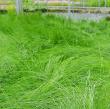
Height: 24 inches
Spread: 24 inches
Sunlight: full sun, partial shade
Hardiness Zone: 5b
Other Names: Stipa tenuissima, Needle Grass
Description:
An extremely delicate looking grass that provides gentle movement and sound in even the most delicate of breezes; a textural feast in the hands of a creative garden designer
Ornamental Features:
Mexican Feather Grass features airy plumes of gold flowers rising above the foliage in mid summer. Its attractive threadlike leaves are green in color. As an added bonus, the foliage turns a gorgeous harvest gold in the fall. The gold seed heads are carried on showy plumes displayed in abundance from late summer to late winter.
Landscape Attributes:
Mexican Feather Grass is a dense herbaceous perennial grass with an upright spreading habit of growth. It brings an extremely fine and delicate texture to the garden composition and should be used to full effect.
This is a relatively low maintenance plant, and is best cleaned up in early spring before it resumes active growth for the season. Gardeners should be aware of the following characteristic(s) that may warrant special consideration:
- Self-Seeding
Mexican Feather Grass is recommended for the following landscape applications:
- Mass Planting
- Rock/Alpine Gardens
- Border Edging
- General Garden Use
Planting & Growing:
Mexican Feather Grass will grow to be about 20 inches tall at maturity, with a spread of 24 inches. Its foliage tends to remain dense right to the ground, not requiring facer plants in front. It grows at a medium rate, and under ideal conditions can be expected to live for approximately 20 years. As an herbaceous perennial, this plant will usually die back to the crown each winter, and will regrow from the base each spring. Be careful not to disturb the crown in late winter when it may not be readily seen!
This plant does best in full sun to partial shade. It prefers dry to average moisture levels with very well-drained soil, and will often die in standing water. It is considered to be drought-tolerant, and thus makes an ideal choice for a low-water garden or xeriscape application. It is not particular as to soil type or pH. It is somewhat tolerant of urban pollution. This species is not originally from North America. It can be propagated by division.
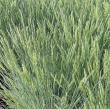
Powder blue foliage. Dense clumping. Semi-evergreen. USDA 4-8
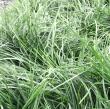
Cool season semi-evergreen ornamental grass. Deep, dark green foliage and airy, golden yellow flowers. USDA 4-9
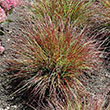
Bright red accent on blades. Compact. Tan seed heads. USDA 5-9
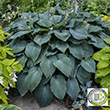
Gigantic, heart-shaped, blue-green leaves are heavy & very slug resistant. Tolerates deep shade and black walnut. USDA 3-8
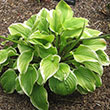
Chartreuse-green leaves with a creamy-yellow edging, and very fragrant near-white flowers mid-sumer. USDA 2-9
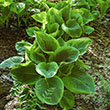
Round, crinkled blue leaves edged in gold. White flowers bloom mid-summer. USDA 3-8
29 found, showing page 1 of 2










